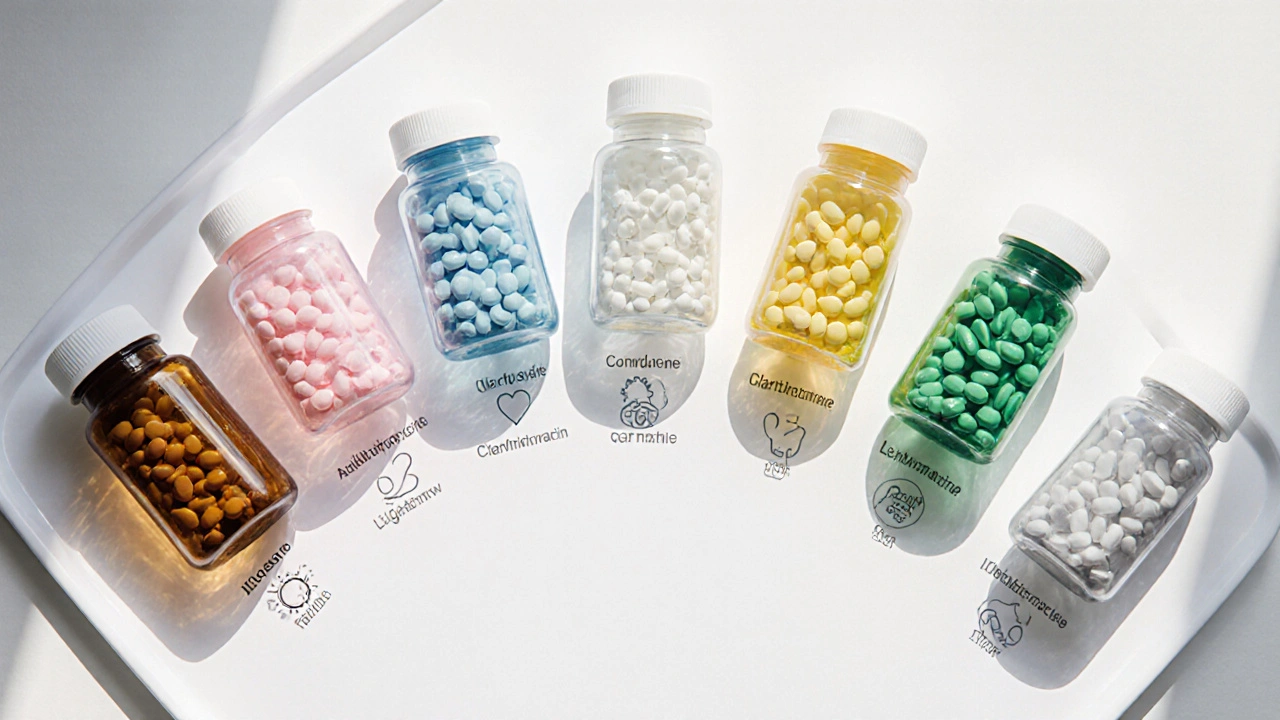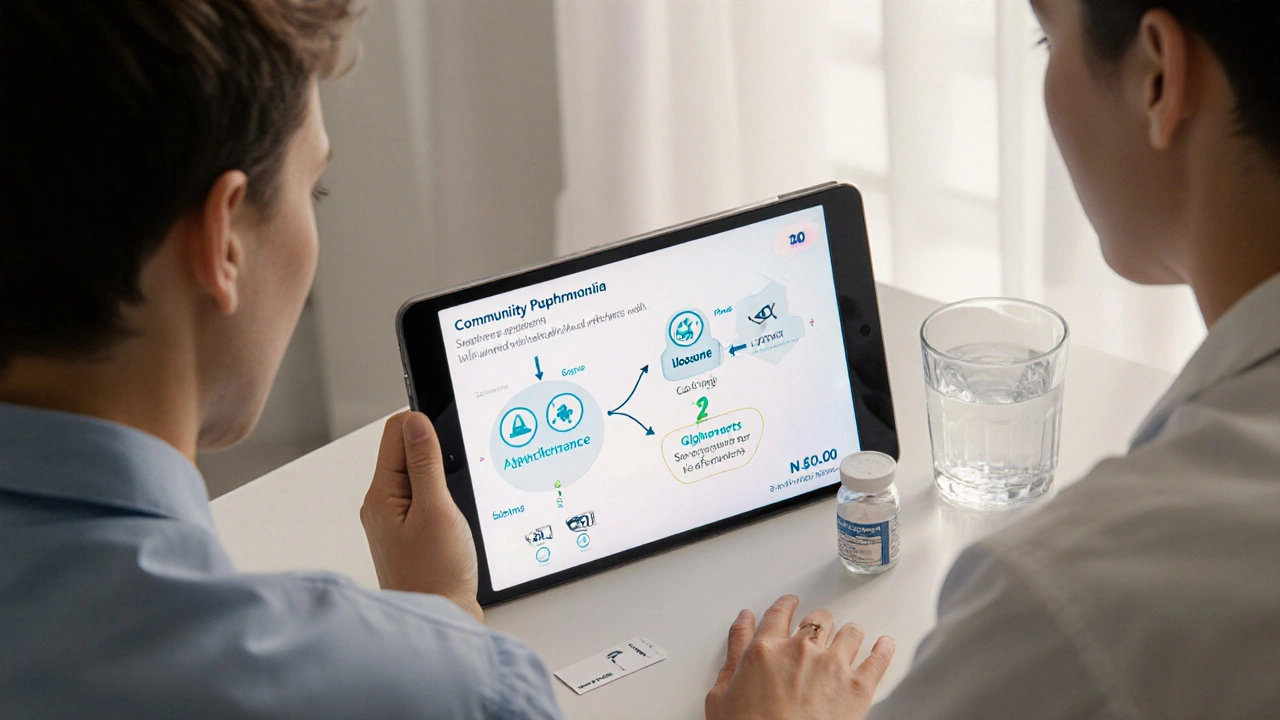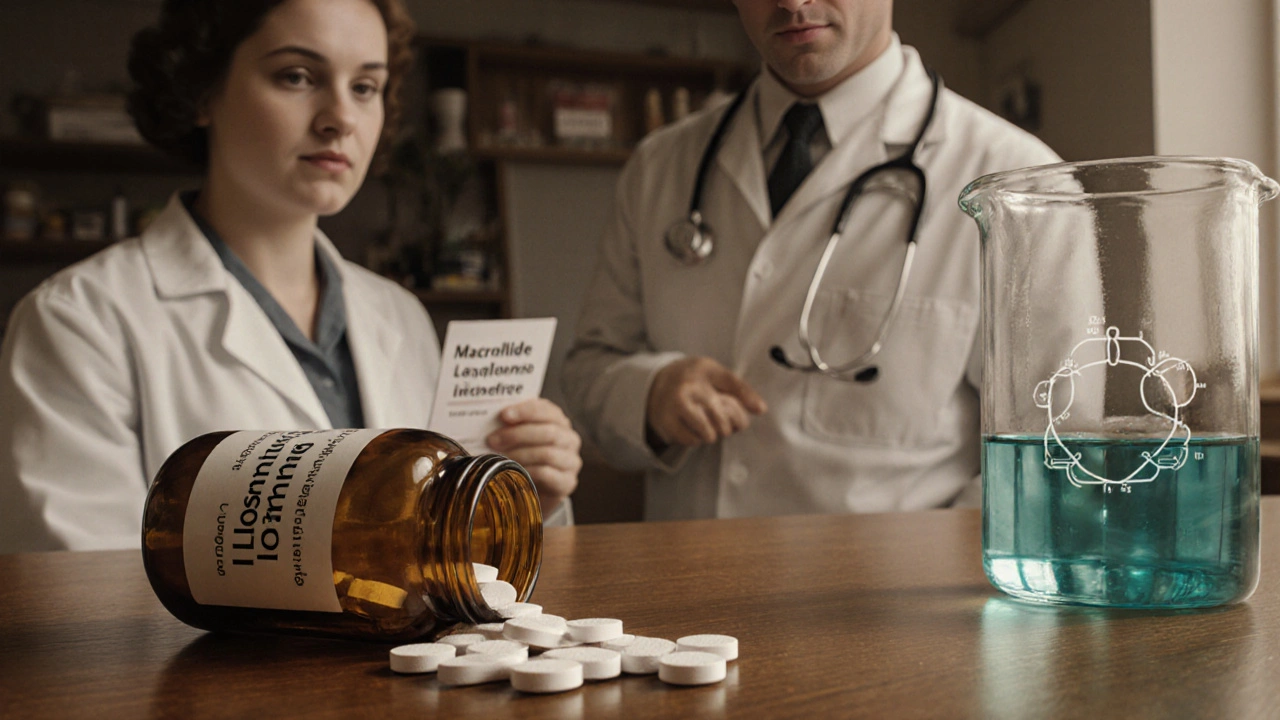Ilosone vs Alternatives: Antibiotic Choice Guide
Recommended Antibiotics
Side Effect Comparison
| Antibiotic | Common Side Effects | Special Considerations |
|---|
When doctors prescribe a macrolide for bacterial infections, Ilosone is a brand name for erythromycin, a broad‑spectrum antibiotic that’s been around since the 1950s. It’s often the go‑to when a patient can’t take penicillin, but the market is crowded with newer macrolides and other classes that promise fewer side effects or simpler dosing. If you’re wondering whether Ilosone is still the right pick or if another option might suit you better, you’re in the right place.
Key Takeaways
- Ilosone works by stopping bacterial protein synthesis, making it effective for many respiratory and skin infections.
- Newer macrolides such as azithromycin and clarithromycin offer once‑daily dosing and fewer GI complaints.
- For atypical or intracellular bacteria, doxycycline and clindamycin can be more potent alternatives.
- Cost and drug‑interaction profiles vary widely; generic erythromycin remains cheap but has notable GI upset.
- Choosing the right antibiotic depends on infection type, patient tolerance, and possible interactions.
What Is Ilosone (Erythromycin)?
Erythromycin belongs to the macrolide family, chemically defined by a large lactone ring that binds to the 50S subunit of bacterial ribosomes. By blocking the exit tunnel for nascent proteins, it halts bacterial growth - a classic bacteriostatic effect, though high doses can be bactericidal.
Key attributes of Ilosone (erythromycin):
- Class: Macrolide antibiotic
- Typical dose: 250‑500mg every 6hours for adults
- Spectrum: Gram‑positive cocci, some Gram‑negative diplococci, atypicals (e.g., Mycoplasma)
- Common uses: Community‑acquired pneumonia, pertussis, skin infections, chlamydia, and gastric ulcer prophylaxis (via motilin stimulation)
How Ilosone Stacks Up Against the Main Alternatives
Below are the most frequently considered substitutes. Each entry includes a brief definition, typical dosing, and the clinical niches where it shines.
Azithromycin - a newer macrolide with a long half‑life, allowing once‑daily dosing for 3‑5days. It’s less likely to cause stomach upset and has a broader reach against atypical pathogens like Legionella.
Clarithromycin - another macrolide, more potent than erythromycin against Haemophilus influenzae and Mycobacterium avium complex. It’s taken twice daily and carries a higher risk of drug‑enzyme interactions (CYP3A4).
Doxycycline - a tetracycline that works by blocking the 30S ribosomal subunit. It’s excellent for tick‑borne diseases, acne, and certain intracellular organisms, but photosensitivity can be an issue.
Clindamycin - a lincosamide that penetrates bone and abscesses well, making it a solid choice for anaerobic skin infections. It’s taken 4‑6 times daily and may trigger C.difficile colitis.
Penicillin V - the classic β‑lactam for streptococcal pharyngitis and mild pneumonia. It’s cheap, very safe, but many patients report a penicillin allergy, which pushes clinicians toward macrolides.
Levofloxacin - a fluoroquinolone with broad Gram‑negative coverage, useful for complicated urinary tract infections. Its safety concerns (tendon rupture, QT prolongation) have limited its first‑line use.
Side‑Effect Profile: Ilosone vs the Competition
Understanding tolerability is crucial because adverse events drive non‑adherence.
- Ilosone (erythromycin): Upset stomach, nausea, vomiting, and a metallic taste are common. High‑dose regimens can cause cholestatic hepatitis.
- Azithromycin: Fewer GI complaints; rare cardiac QT‑prolongation, especially with concurrent QT‑affecting meds.
- Clarithromycin: Similar GI profile to erythromycin but with higher rates of taste alteration and drug‑enzyme interactions.
- Doxycycline: Sun sensitivity, esophageal irritation, and possible yeast infections.
- Clindamycin: Notable risk of C.difficile infection, which can be severe.
- Penicillin V: Generally well tolerated; allergic reactions range from rash to anaphylaxis.
- Levofloxacin: Tendon inflammation, CNS effects, and QT prolongation, especially in older adults.

Cost and Accessibility
Price often decides the final prescription, especially in public‑health settings.
- Ilosone: Generic erythromycin tablets cost about NZ$0.20 per 250mg tablet in New Zealand pharmacies.
- Azithromycin: A 5‑day pack (250mg) runs roughly NZ$4‑5, a bit pricier but still affordable.
- Clarithromycin: Typically NZ$6‑8 for a 10‑day course.
- Doxycycline: Around NZ$0.15 per 100mg tablet, making it one of the cheapest options.
- Clindamycin: NZ$0.30 per capsule; higher if extended‑release forms are used.
- Penicillin V: Often under NZ$0.10 per tablet.
- Levofloxacin: NZ$2‑3 per 500mg tablet, but insurance coverage varies.
Choosing the Right Antibiotic: Decision Guide
Below is a quick rule‑of‑thumb chart to help you match infection type with the most suitable drug.
| Infection | First‑line choice | When to switch | Key consideration |
|---|---|---|---|
| Community‑acquired pneumonia (typical) | Ilosone (erythromycin) | Azithromycin if GI upset occurs | Drug interactions (CYP3A4) |
| Atypical pneumonia (Mycoplasma, Legionella) | Azithromycin | Clarithromycin if resistance suspected | QT‑prolongation risk |
| Skin and soft‑tissue infection (mixed aerobic/anaerobic) | Clindamycin | Ilosone if patient cannot tolerate clindamycin | C.difficile potential |
| Chlamydia trachomatis | Ilosone | Doxycycline if patient prefers once‑daily dosing | Pregnancy safety (doxycycline contraindicated) |
| Streptococcal pharyngitis | Penicillin V | Azithromycin for penicillin‑allergic patients | Allergy history |
Notice how the table aligns each infection with a primary agent, an alternative, and the factor that might push you toward the backup drug. Use it as a cheat sheet when you’re discussing options with your pharmacist or doctor.
Practical Tips for Reducing Side Effects
- Take Ilosone with food or a full glass of water to blunt nausea.
- If you experience heartburn, an OTC antacid (calcium carbonate) can help, but avoid antacids containing aluminum or magnesium within two hours of the dose because they may reduce absorption.
- For any macrolide, avoid grapefruit juice - it can raise blood levels and increase the chance of cardiac events.
- Stay hydrated and consider a probiotic during a prolonged course to protect gut flora, especially when using clindamycin.
- If you’re on chronic meds (statins, warfarin, carbamazepine), double‑check with your prescriber because erythromycin and clarithromycin can magnify their effects.
When Not to Use Ilosone
Even a tried‑and‑true antibiotic isn’t perfect. Avoid Ilosone if:
- You have a known erythromycin or macrolide allergy (manifesting as hives, swelling, or anaphylaxis).
- You’ve had a recent episode of C.difficile infection - the drug’s impact on gut bacteria can trigger recurrence.
- You’re pregnant and the infection can be safely treated with penicillin; macrolides cross the placenta and are generally safe but not first‑choice when alternatives exist.
- You’re on a medication that heavily relies on CYP3A4 metabolism (e.g., certain statins, anti‑arrhythmics), unless dosage adjustments are made.
Bottom Line: Is Ilosone Still Worth It?
If you need an inexpensive, widely available macrolide for a classic respiratory infection and you tolerate oral meds well, Ilosone remains a solid pick. However, for patients who struggle with stomach upset, require once‑daily dosing, or are on multiple interacting drugs, azithromycin or clarithromycin often provide a smoother experience. Always let your healthcare provider weigh the infection type, resistance patterns in your region, and your personal health profile before finalizing the prescription.

Frequently Asked Questions
Can I take Ilosone while pregnant?
Erythromycin is classified as Category B in pregnancy, meaning animal studies haven’t shown a risk but there are limited human data. It’s generally considered safe if the benefits outweigh any potential risk, but many clinicians prefer penicillin or ampicillin for common infections during pregnancy.
How long should a typical course of Ilosone last?
For most respiratory infections, a 7‑ to 10‑day course is standard. Some skin infections may require 14 days, while prophylactic use for gastric ulcer prevention can be as short as 2 weeks.
Is there a risk of antibiotic resistance with Ilosone?
Yes. Overuse of macrolides can select for resistant strains of Streptococcus pneumoniae and Haemophilus influenzae. That’s why doctors reserve Ilosone for cases where first‑line β‑lactams aren’t suitable.
Can I switch from Ilosone to azithromycin midway through treatment?
Switching is possible, but only if the infection is responding and the doctor confirms the dosage equivalence. Azithromycin’s longer half‑life means you’ll finish the remaining course in fewer days.
What should I do if I develop severe diarrhea while on Ilosone?
Severe watery stools could signal C.difficile infection. Stop the antibiotic immediately, contact your healthcare provider, and get tested. Prompt treatment with oral vancomycin or fidaxomicin is usually required.

Tracy Winn
October 2, 2025 AT 20:43Alright, let’s cut to the chase: Ilosone (erythromycin) is cheap, it works, but the GI upset can really ruin a day, especially if you’re already battling a cough. Take it with food, stay hydrated, and maybe pop a probiotic if you’re on a longer course – that’s the practical takeaway, no fluff.
Jessica Wheeler
October 14, 2025 AT 02:43While it’s true that the cost‑effectiveness of Ilosone is appealing, the moral imperative to minimize patient discomfort should not be ignored; therefore, prescribing azithromycin when GI distress is likely is the more ethical choice.
Mikayla Blum
October 25, 2025 AT 08:43you know, thinking about drug‑choice is kinda like choosing a coffee-some folks love the old‑school drip, others want the fancy latte. ilosone is the drip, familiar and reliable, but if you’re sensitive, the latte (azithro) might just save your morning. :)
Jo D
November 5, 2025 AT 13:43Oh, great, another macrolide showdown-let’s get real. If you’re craving a jargon‑filled discussion about CYP3A4 interactions and QT‑interval drama, then sure, keep debating. In practice, most patients just want a pill that stops the bug without turning their stomach into a volcano.
Sinead McArdle
November 16, 2025 AT 19:43Respectfully, the core point is clear: weigh side‑effects against efficacy, and choose the simpler regimen when possible.
Katherine Krucker Merkle
November 28, 2025 AT 01:43I appreciate the thorough breakdown-it’s helpful to see the side‑effect profiles side by side. Makes the decision feel less like a gamble.
Mark Quintana
December 9, 2025 AT 07:43i think its good to check if the patient has any prior c.diff because ilosone can be a trigger, also watch out for drug interactions with statins.
Brandon Cassidy
December 20, 2025 AT 13:43One could argue that the philosophical underpinnings of antibiotic stewardship call for a more nuanced approach-balancing immediacy of cure with long‑term ecological impact, though the everyday clinician might simply need clear, actionable guidance.